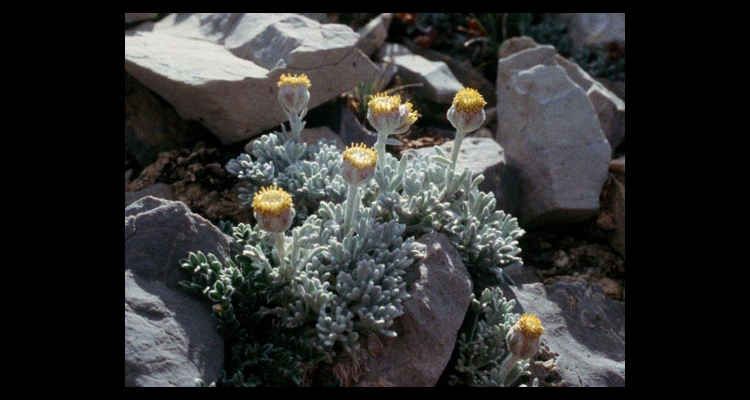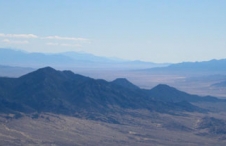Nevada Vegetation Overview
Nevada's unique geography and rugged topography have given rise to a diversity of vegetation types. Great Basin vegetation occupies the northern part of the state, a region of high, sagebrush-dominated valleys and numerous mountain ranges. Mojave Desert vegetation dominates the southern part, with the boundary between these two main ecological zones occurring roughly between Goldfield and Beatty. The Great Basin is considered a “cold desert” because of its snowy winters, although summers can be quite hot and dry. The Mojave Desert is known for extremely hot summers, but it has cool winter temperatures.
Much of the Mojave Desert is covered in creosote bush (Larrea tridentata), a widely distributed shrub with olive-colored foliage that is resinous and exudes a strong creosote odor. Creosote bush grows in clones (genetically identical clusters) of great longevity, dating as old as 11,000 years, making this species among the longest-lived plants. However, while the clones are long-lived in the sense that they continually resprout, individual stems are seldom more than a few centuries old. Creosote bush occurs with white burrobush (Ambrosia dumosa) on deep, sandy soils and with shadscale (Atriplex confertifolia) on shallower soils. The shallow soils often have “desert pavement” on the surface or are underlain by caliche (hard layers of calcium carbonate that are nearly impervious to water penetration). At higher elevations, creosote bush diminishes, and blackbrush (Coleogyne ramosissima) becomes more abundant.
The overall structure of Mojave vegetation is dominated by desert shrubs, generally of short to medium height and somewhat evenly spaced. However, other plant life forms are important including grasses, herbaceous flowering plants, succulent (water-storing) species such as cacti and yucca, and even some trees. Many annual plant species in the Mojave emerge only in years with strong winter rains (winter annuals) or summer rains (summer annuals), causing the “desert to bloom” during irregular, favorable periods. Annual plants germinate, grow to reproductive maturity, flower, set seed, and die within a single growing season. Seeds, however, can persist and remain viable for many years in the soil, awaiting the next significant rainfall. Some annual plant species in the desert complete their entire life cycles in 6-8 weeks or less (desert ephemeral species), thus avoiding the brutally hot summers.
Desert oases surround spring-fed pools or occur where groundwater is sufficiently close to the surface. Such ecosystems do not suffer the same water limitations as the surrounding landscape and so include a diversity of plant species not found elsewhere. Tree species include screwbean mesquite (Prosopis pubescens), western honey mesquite (Prosopis glandulosa), velvet ash (Fraxinus velutina), several willow species including Salix exigua and Salix gooddingii, and Fremont's cottonwood (Populus fremontii). Woodland, wet meadow, marsh, and shrub thicket plant communities occur in complex mosaics, and due to the vast distances separating many desert spring ecosystems, often include species that have evolved or persisted in isolation and occur nowhere else (endemic species). For example, Southern Nevada supports at least 24 endemic species (the highest concentration in the United States), including several plants.
The Joshua tree (Yucca brevifolia), an unusual member of the lily family that grows to 30 feet in height and occurs in extensive, open stands, grows on high alluvial fans and marks the transition zone between the Mojave and Great Basin deserts. Its northernmost occurrence is in the vicinity of Goldfield, although it reaches its greatest abundance far to the south. With twisty branches protruding like arms askew from a thick, fibrous trunk and large clusters of off-white flowers in the springtime, the Joshua tree is often remarked upon by the passing traveler.
Nevada's other important vegetation types are characteristic of the Great Basin and vary according to elevational zone. Rainfall increases and temperature decreases with increasing elevation from valley bottom to mountain peak. Many of Nevada's higher mountain ranges are covered in snow all winter, while many valley bottoms are snow-free for much of the season. The distribution of plant species tracks these climatic differences, resulting in a similar zonation of vegetation types in the various mountain ranges. Since the Great Basin includes 314 named mountain ranges, most of them trending in a north-south direction, there is much variability in vegetation as one progresses in a latitudinal direction across the state.
For simplicity, the Great Basin's vegetation zones can be lumped into several distinct types: Salt Desert (Shadscale Zone), Sagebrush Grassland, Pinyon-Juniper Woodland, Mountain Shrub, Subalpine Forest, and Alpine Tundra. Salt Desert and Sagebrush Grassland are characteristic of valley bottoms. Salt Desert is most prevalent in the low, saline valleys of the Lahontan Basin in western Nevada. In the poorly drained playas characteristic of this vegetation type, the water table fluctuates periodically. This results in the development of a salty crust on the surface, as well as extensive wind erosion during dry periods. Plant species that occur in the Salt Desert, such as shadscale (Atriplex confertifolia) and greasewood (Sarcobatus vermiculatus), are well adapted to high salt levels and drought conditions. Although there is more biodiversity here than meets the eye, the general aspect of this vegetation type is one of uniformity, as it is dominated by low, nondescript shrubs that are often spiny and of a greenish-gray hue. Vegetation cover is typically only about 10–15% of the ground surface.
At somewhat higher elevations and on well-drained soils, Salt Desert transitions into Sagebrush Grassland. Shrubs here are taller and less spiny than in the Salt Desert zone, and vegetation cover is typically 15–40%. Annual precipitation of at least eight inches is typically required to support this vegetation type. Dominant shrub species include big sagebrush, low sagebrush (Artemisia arbuscula var. arbuscula), black sagebrush (Artemisa arbuscula var. nova), Ephedra species, antelope bitterbrush (Purshia tridentata), spiny hopsage (Grayia spinosa), desert gooseberry (Ribes velutinum), snowberry, (Symphoricarpos spp.), littleleaf horsebrush (Tetradymia glabrata), and rabbitbrush (Chrysothamnus spp.). Also important in the Sagebrush Grassland are a variety of forbs (flowering herbaceous plants) and perennial bunchgrasses such as Great Basin wild rye (Leymus cinereus), squirreltail (Elymus elymoides), needle-and-thread (Heterostipa comata), and Indian rice grass (Oryzopsis hymenoides). Such grasses are referred to as “perennial” because plants survive over multiple seasons, allowing them to develop deep root systems for surviving drought. Perennial grasses also have the ability to resprout following disturbances such as fire.
The balance between shrub and grass dominance in the Sagebrush Grassland zone depends upon the timing and overall amount of precipitation, land use history, and grazing practices. More abundant precipitation favors bunchgrasses, particularly if it occurs as rainfall in summer months (i.e. a more monsoonal climate). Over-grazing favors shrubs of low palatability, such as big sagebrush. It is widely believed that prior to Euro-American settlement, perennial bunchgrasses were much more abundant in the Sagebrush Grassland zone than they are today.
Invasion by exotic plant species such as cheatgrass (Bromus tectorum) is also prevalent in this vegetation zone. Because it dries out in early summer and becomes highly flammable, cheatgrass changes the fire frequencies in sagebrush communities from 50 or more years to 10 or fewer years between burns. After a few fires, slow-growing, fire intolerant shrubs are eliminated, and a cheatgrass monoculture becomes established. Such a vegetation type is of little use to wildlife or livestock.
Thus far the vegetation cover of the valleys and low playas has been described. The mountain ranges of the Great Basin are dissected by innumerable canyons, which often contain Sagebrush Grassland vegetation at their bottoms. Such areas may have been kept free of trees in the past by repeated fires, either natural or set by Native Americans and early ranchers. In recent decades, many canyon bottoms have been invaded by pinyon-juniper woodland. Riparian plant communities occur where perennial streams flow through canyon bottoms. Such communities may be dominated by grassy meadows, shrubs, or trees, depending upon the physical setting, geology, flood regime, and history of human disturbance characteristic of a particular canyon. Narrow stringers of flood-adapted tree and shrub species occur along steep, confined reaches. Stately groves of quaking aspen (Populus tremuloides) and narrowleaf cottonwood (Populus angustifolia) can be found in deep canyons of many Great Basin mountain ranges. More familiar to many is the Fremont cottonwood (Populus fremontii) that lines the banks of the major rivers (Truckee, Carson, and Walker), achieving large size and filling the air with white fluff in springtime. Common shrubs of the Great Basin riparian zone include water birch (Betula occidentalis), wild rose (Rosa woodsii) and several willow species (Salix spp.) Finally, geomorphic features such as debris fans sometimes create areas of elevated water tables in the riparian zone, giving rise to wet meadows dominated by graminoids (grasses, sedges and rushes).
Above the canyon floors lies the Pinyon-Juniper Woodland, often a broad belt that begins at the margin of mountain and valley and extends upwards to approximately 7000 feet in elevation. However, the elevational limit varies with latitude, and some valley bottoms in Eastern Nevada are at a sufficiently high in elevation for woodland to cover them as well as the mountain slopes. Development of substantial tree cover generally requires annual precipitation of at least 12 inches. This zone is typically a complex mosaic of shrub- and tree-dominated patches, intergrading into mountain shrub communities at higher elevations and on north-facing aspects. Dominant tree species are singleleaf pinyon pine, Pinus monophylla, and Utah juniper, Juniperus osteosperma.
Many of Nevada's mountain ranges lack subalpine forest vegetation. Instead, pinyon-juniper woodland gives way to a diverse Mountain Shrub community at higher elevations and on moister sites. Mountain mahogany (Cercocarpus ledifolus) is a small but handsome tree, with an extremely dense and purplish wood that sometimes forms nearly impenetrable thickets in this zone. Often the Mountain Shrub community occurs as a band below the drought tolerance limit of high-elevation coniferous tree species such as limber pine (Pinus flexilis) and bristlecone pine (Pinus longaeva) but above the cold tolerance limit of pinyon and juniper. Bristlecone pine tends to dominate high mountains of the southern part of the state, while limber pine is more common in the north and central mountain ranges. Both species form an open woodland of trees that can reach great age and twisted proportions, with shrub-like “krummholz” growth forms at treeline. At the edges of the Great Basin are found diverse subalpine forests more typical of the neighboring Sierra Nevada or of Utah's Wasatch Range. For example, the Snake Range of Eastern Nevada harbors dense, mixed conifer forests including Engelmann spruce (Picea engelmannii) and Douglas fir (Pseudotsuga menziesii) in addition to limber and bristlecone pines.
On only a handful of the tallest mountain ranges, where elevations exceed 10,000–12,000 feet, the mountain shrub or subalpine forest vegetation gives way to true Alpine Tundra. This vegetation zone consists of low perennial herbaceous plants, including grasses, sedges and forbs, and cushion plants such as fewseed draba (Draba oligosperma). Herbaceous plants in the alpine zone often form dense mats, while shrub species tend toward dwarf and prostrate growth forms. These adaptations minimize stress to the plants from cold temperatures, snow, and wind.
Distance along an east-west gradient influences whether plant communities include more species characteristic of the Sierra Nevada to the west or of the Rocky Mountains to the east. However, Rocky Mountain influences generally predominate because of the similarly dry conditions and the inhospitable Lahontan Basin separating most of Nevada's mountain ranges from the Sierra Nevada. Nevada is characterized by a multiplicity of vegetation types and habitats, following its rugged and mountainous nature.







